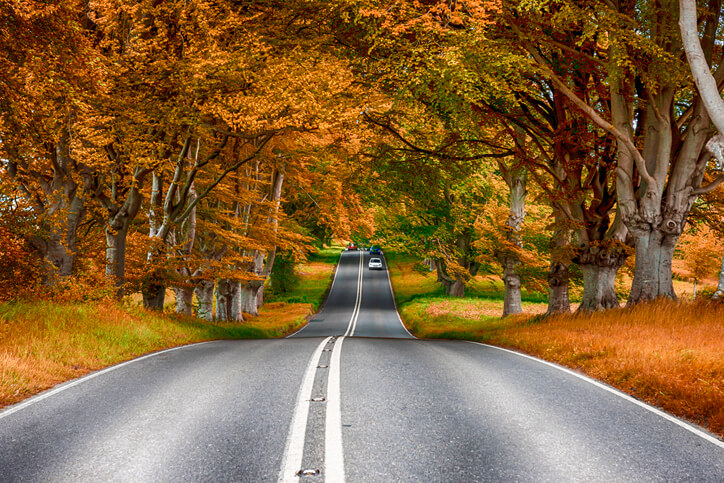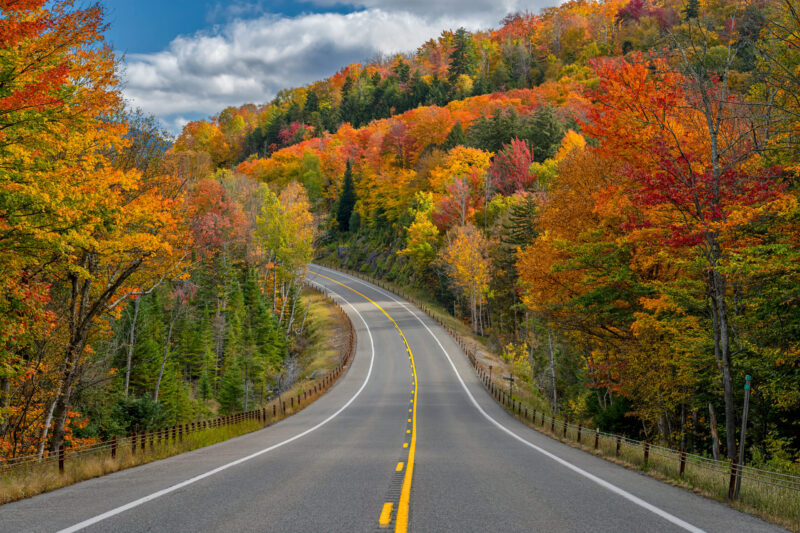As the autumn season arrives, the dramatic display of colorful leaves is a great reason to hit the open road and do some leaf peeping. In the words of Albert Camus, “Autumn is a second spring when every leaf is a flower.” Whether you opt for a leisurely drive around town, take a day trip somewhere close by or head out on an epic road trip, gazing at spectacular fall foliage is a feel-good activity that’s free to enjoy. What more can you ask for?
Why Leaves Change Color
Trees, vines, bushes and shrubs dress themselves up in a dazzling rainbow of colors for the fall – but have you ever wondered how they make this magic happen? As summer fades into fall, the days get shorter, meaning there are fewer hours of sunlight. The lack of sunlight and increasingly cooler nights is a signal to the leaves to stop producing chlorophyll, which is the pigment that gives leaves their green coloring the rest of the year. As the chlorophyll breaks down, other pigments appear, creating the beautiful ranges of reds, purples, yellows and oranges that you see in the autumn.
Love fall? Check out these Fall Home Decor Ideas Picked from the Pumpkin Patch.
When Leaves Will Start to Change
Officially, autumn begins on September 22nd, but you won’t really know it by looking at the trees in most parts of the country. Although the transition away from green varies slightly from year to year and depends on how long it takes the warm summer temperatures to fade, trees in the most northern parts of the country start to get a touch of fall color by mid-September.
The transition to color slowly progresses into the middle and lower regions of the country, as trees transform in the following weeks. As you might expect, the warmer regions of the country see the transition later in the year, with the first changes arriving in early-to-mid October.
The first signs of fall color will always be detected in the most northern parts of the country – and also in the most elevated regions. For example, in Great Smoky Mountains National Park, colors change as early as the first or second week of September where the elevation is over 4,000 feet. The forested areas below this level remain mostly green until about mid-October.
The Look of Autumn Where You Are
While viewing the fall foliage is a popular annual ritual for anyone in the New England area, those living in places like Arizona or southern California aren’t used to experiencing a dramatic change in seasons. How flashy the local fall foliage will be – or not – depends on the kinds of trees that grow in your area.

If you’re in a climate that supports large swathes of evergreen trees, you’ll have to really be on the lookout for colorful trees in the autumn. Evergreen trees are just what they sound like – they stay green all year round. When seeking out fall foliage spots, the most dramatic scenery will have little to no growth of evergreen trees. In the cooler climates, pine, spruce, cedar and fir trees don’t change color in the fall; they maintain their sturdy, deep green needles or thick leaves throughout the year. Palm trees, found in the warmer climates, will also keep their tropical, feathery green fronds throughout the fall, although they do shed leaves regularly.
Statistically, the amount of autumn scenery you’ll encounter is also determined by the density of trees in your state. The most popular fall foliage spots are:
- Maine
- New Hampshire
- West Virginia
- Vermont
The territory of these states boast between 78 to 90% forest coverage. On the other hand, North Dakota, South Dakota and Nebraska rank at the very bottom of the list, with only 1 to 2% forest coverage. That doesn’t mean these states won’t have fall colors in certain spots, but if you’re driving through, it’ll be harder to spot any dramatic foliage.
Autumn Colors by Tree
Another way to predict the autumn display in your area is to know the colors produced by the trees. If you can identify the trees, use the chart below to find out what colors you can expect in the fall. The shade and intensity of color will depend on where you are in the country and the weather that occurs during the fall season.

Take a Fall Foliage Road Trip
Don’t live near a fall foliage hot spot? Time to plan a road trip! For a leisurely day trip, choose the most scenic route through the countryside. At a slower speed you’ll be able to take in the most trees. Check the map for parks or viewpoints along the way. You can stop for a lunch break or just to take pictures. If you’re planning a longer trip of a few days or few weeks, perhaps in your RV, then choose your route according to the peak viewing time of the places you want to see most. For example, to see the trees at their most mesmerizing moment along the east coast, drive from north to south. Fall colors appear first in the more northern regions. Just remember to call or check the state park website in advance to confirm opening hours and camping guidelines.

When to Expect Peak Viewing
The most dramatic moment of the fall colors can come and go within a week or 10 days. And the timing all depends on which part of the country you’re in. In the last decade, peak viewing time has been around October 5th through the 11th. This year experts predict the height of the fall colors to arrive a little later in most of the country – around mid-October.
In the Pacific Northwest, Washington and Oregon will be at their peak viewing point from about October 12th through the 19th. The middle part of the country runs on a later schedule. Peak viewing in Tennessee (including the popular Great Smoky Mountain National Park) and Kentucky is in the last few days of October through the first week of November. Similarly, Hill Country in central Texas and other warmer states display peak viewing time in the last week of October and lasting through the first and second weeks of November.
The Farmer’s Almanac has been giving out advice on the ways of Mother Nature since 1792. The online version features an annually updated list of the dates for peak fall foliage by state.

Popular Leaf-Peeping Sites Across the U.S. – Where to Go and When
Ready to go check out some gorgeous autumn colors but not sure where to start? Here’s a round-up of some beloved leaf viewing spots from around the country – and when to go for peak viewing. But remember that weather plays an important role in the timing of the color transition. Before you head out, confirm the peak viewing date range with the official state tourism website or national park website. Most states even have a fall foliage hotline. Call to get the most up-to-date information on the local trees.
- Great Smoky Mountain National Park, Tennessee: mid-October – early November in lower elevations
- Ozark National Forest, Arkansas: October 12 – 28
- Stowe, Vermont: September 24 – October 10
- Bar Harbor, Maine: October 5 – 21
- Shenandoah Valley, Virginia: mid-October – early November
- Eastern Shore, Maryland: October 19 – November 4
- Poconos Mountains, Pennsylvania: October 5 – 21
- The Enchanted Circle, New Mexico: September 28 – October 9
- Brown County State Park, Indiana: October 12 – 28
- Hill Country, Texas: November 2 – 11
Of course, this list is just a sampling of the many wonderful fall foliage places that exist across the country. Do you have a favorite spot for viewing gorgeous fall colors? Let us know in the comments!







Simply beautiful!
I always thought Wisconsin is a great state to see fall leaf color changes, probably because it’s convenient to visit from my northern Illinois home.
Northlandz is a unique attraction in Flemington, New Jersey, showcasing the world’s largest model railway. The sprawling complex features over 100 trains traveling through intricate landscapes, including cities, mountains, and tunnels. Visitors of all ages will surely be amazed by the incredible detail and artistry displayed throughout the exhibits.
Being from the Caribbean i never got to see much leaf change. Since living in NC its one of my fav time of the year!
Although I enjoyed reading about the colors in New England, I believe this article is remiss in “leaving” out all the colors & scenic routes in Colorado, Michigan, Wisconsin – and so many other states where Hartford customers live & travel.
For a map that shows the status of leaf color change throughout the U.S., do a web search for “fall foliage map”
My favorite – Watkins Glen state park NY
So, so beautiful. I think I am going to buy/rent a motor home and take the grand tour! You only live once and this is one of God’s gifts that should not be missed.
As a native of California, I didn’t see my first fall foliage until I was 11, when a family wedding took place in Yosemite valley at the peak of the color. It blew me away. I remember climbing Bridal Veil Falls the morning of the wedding, and at the trail’s top seeing the valley spread before me in all its glory. On the spot, I vowed that someday I would be married in Yosemite, which seemed to me to be the great heart of the world. Eleven years later, I returned to the little chapel in the valley for my own wedding—not in October, but on Dec. 21, the longest night of the year, when the landscape was dusted by a magical light snowfall. Unforgettable.
Betsy Burr
That is such a beautiful story, Betsy! Thank you for sharing.
I have lived in Northern California my entire life so I’m not unfamiliar with some fall colors. A few years ago I went hunting in Montana and saw groves of aspen around streams and springs that were such bright yellow in contrast to the ever present evergreens and the awesome blue sky. Something I will never forget
I love Autumn one of my favorite times of the year. I use to live in Tennessee and I thought there was nothing more beautiful than the turning color of the leaves. I am going back soon for a visit and I hope the leaves will be turning.
Naomi
Here in Utah, the Cottonwood trees are especially beautiful in the fall.
Why did you not mention Michigan?!
Definitely on my bucket list!
This was very beautiful. I am from the Caribbean and we do not have such luxury so I was very excited the first time I saw fall foliage. Thanks very much for the article.
This entry includes so much more info than other people, and it’s immensly helpful to me. Will be returning to see future writing from you! can I share this?
I love the fall colors!
Wow… great information. . Autumn colors by tree type, just put the topping on the cake. THANK YOU.
Autumn weather is the best.
Thanks Judy!
I love this time of year
Not a fan of the term Fall
It reminds me of Xmas
It’s Autumn people -:)
Thank you so much for the info on the foliage changes from state to state. I realize that the peak times maybe somewhat a little different at times but it gives me an idea approximately when I can expect to see such a beautiful sight. Since the very first time I saw the lovely colors I thought that was one of the most beautiful thing that I had ever seen. It gives me such an unimaginable feeling beyond that which words cannot express. I wanted to go travel during that time of year every fall but sometimes we would miss when the colors are at their highest peak because we did not know exactly when the leaves would be in their full colors So we would either be too early or too late. So again I say, “Thank You!”
Autumn is a great time for a trip across Pennsylvania on Rt 80 or the turnpike.
Great article — informative and inspiring. Thanks!
Pennsylvania is a beautiful Commonwealth year round but particularly beautiful during the autumn. One of the most spectacular autumn color shows can be seen in the mountain areas of the Laurel Highlands. The trees are already beginning to change.
My favorite viewing spot is at West Fork Oak Creek Canyon Park which lies about 15 miles north of Sedona, AZ on Hwy 89. At an elevation of almost a mile high, the oaks and other hardwoods there display peak leaf colors during first two weeks of Oct usually. Contrast the leaf colors against the high red sandstone cliffs and it’s an experience every hiker and camera buff should do at least once in their lifetime!
It sounds absolutely beautiful! Thanks for sharing.
I live in Florida. No fall colors here. Why send this kind of info to a Floridian?
Maybe you’ll be inspired to plan a trip to one of these beautiful locations in the future.
Crunching fall leaves is a sound I look forward too almost as much as the colors.
Michigan is another one of God’s sites painted with rich fall colors!
for a very viewing of fall colors is from Alton,Illinois up the great river road thru pere Marquette Park along the Mississippi River
Thank you you made my day
fall is my favorite season. Do you have any recommendations with this pandemic and all these fires going on ?
I used to live in Washington State and was frequently treated to wonderful Fall colors driving along the Columbia River. Your picture is stunning.
I am going say Flagstaff, Arizona. Since I live in Arizona. I would say say late August beginning of Sept. I just remember going up there with my son, that was in college at the time at NAU. We would be searching for apartments. I would take walks and pick them up. So gorgeous in color. Miss those days!!